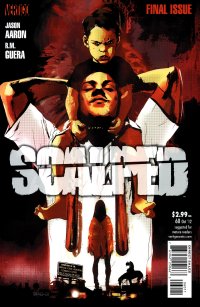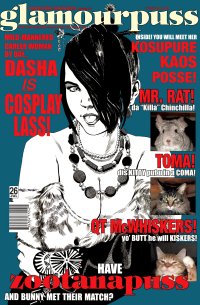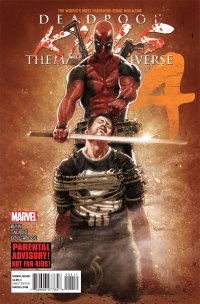Scalped #60 (Vertigo, $2.99)
By Jeb D.
The modern hard-boiled noir requires a tricky balancing act between the unfamiliar and the inevitable: finding new and different character types, venues, and situations draws the reader in, but they must convincingly carry the weight of knowledge that death and doom hang over the characters’ heads. In the end, no matter how an author chooses to populate or situate his story, the conclusion needs to feel as though it were the only possible one: much as it may hurt, it had to end this way.
One of the great virtues of Jason Aaron and R.M. Guera’s Scalped, now concluded with its final issue, is that the unfamiliar elements—the realistic setting of the poverty and misery of a modern Indian reservation, the layers of duplicity and betrayal, the vividly distinct characters—have been so strong that it was almost irrelevant whether they actually stuck the landing: the dark, violent world of Prarie Rose Reservation, the sad façade of the cheap glamour of the casinos, and their contrast with the misery of life on the rez… no reader could have asked for a more absorbing, lived-in environment to spend time in. Similarly strong was the unforgettable cast: conflicted loner Dashiell Bad Horse; the powerful, ruthless, and startlingly vulnerable Lincoln Red Crow; Gina Bad Horse, Dashiell’s beloved, doomed mother; the monstrous Catcher, the obsessed Nitz; a female supporting cast of welcome strength and diversity (including Granny Poor Bear, Carol Ellroy, and Maggie Rock Medicine), and the procession of intriguers, gangsters, friends, opportunists, loved ones, fools, and victims among whom they all moved; some found redemption, some rejected it, but living with them for the past five years has been an amazing journey, one that could have ended with the last pages of #59—one of the great comic-book action sequences, topped off with Dash, Lincoln and Catcher in a three-way standoff, guns blazing—and I’d have been more or less satisfied.
Well, not really… given that Aaron and Guera had the opportunity to tell their story at their pace, at their preferred length, knowing “how it ends,” and having that ending work, was important, and issue #60 puts the appropriate cap on things. Obviously, no one following the series up to this point needs to be told to read the final installment, and no one who’s been thinking about trying it is going to start at the end, but it is worth noting that providing closure to most of the characters doesn’t keep Aaron and Guera from ramping up the action yet again: the opening pages of #60 are typically brutal and uncompromising. From there, we get a few more revelations, some bitter and bittersweet farewells, a hint of transformation and the sense that a form of justice sometimes comes to the deserving. In some ways, the ending also feels like a new beginning, but Aaron has says that he’s not planning any more Scalped, and while it’s possible to imagine more stories that could be told in this setting, they’re not necessary: the throughline from Indian Country, the first story arc, through the absorbing stories of characters like Diesel, Franklin Falls Down, Shunka, and Sheriff Kurnow, to the concluding Trail’s End, has been as involving and moving as any comic I’ve read in years. It may hurt to know that I won’t be reading new installments of Scalped any more, but honestly, it had to end this way.
Scalped #1-60: Rating: 




Out of a Possible 5 Stars
 Spaceman #9 ($2.99, Vertigo)
Spaceman #9 ($2.99, Vertigo)
by D.S. Randlett (@dsrandlett)
Brian Azzarello’s post 100 Bullets phase has been an interesting thing. Azzarello has been taken into the mainline DC fold, working on titles like Wonder Woman and Rorschach, the latter of which seems like something much more in his wheelhouse, while Wonder Woman and his recently concluded Vertigo effort with longtime collaborator Eduardo Risso, Spaceman, are either precisely what you do not expect from him in the case of the former or else a new take on what you might expect in the case of the latter.
Spaceman has been an interesting series that I haven’t heard much about, but having read through the run twice now, it’s easy to see why. It’s a lot like some of his 100 Bullets runs in that the import of the story doesn’t really sink in until a few readings later, and is thus somewhat closed off from the aspect of critical culture that goes to the web with an immediate reaction. That slow burn has become something of an Azzarello hallmark for me. The Azzarello reading process has become something of a long game wherein I pick up a new series, wonder exactly what he’s getting at, and then finally get it after about three readings. He’s really good at finding these hidden rhythms in the way that people talk, and he folds that rhythm into these stories. As such, moments that would be treated as “big moments” by any other writer sink into the milieu of the story. As such, it takes a few readings of his work to really suss out those details and fully experience the complex drama and thematic richness that Azzarello typically brings to bear.
Spaceman marks an interesting point for Azzarello’s style. I remember reading an interview with him, I believe one that was conducted in this very column by CHUD alum Sean Fahey, where Azzarello described an interesting element of his process. If he wanted to get the flavor for a region’s speech he would just hang out in a bar for a while and soak it in. With Spaceman, which postulates speech patterns that have yet been unheard and a future that seems horribly imminent, he has no bar to go to. Although, it seems that Azzarello has spent some time on the internet, for his characters here speak an odd internet pidgin that is sometimes outright baffling. I can see people getting frustrated with this, as I think that sense of befuddlement is part of the point of this series, and a real source of horror for the characters who seem trapped in an unending hell without the ability to really communicate in a language that allows them to express anything beyond their base desires. Still, that old human feeling that they are more than that persists, and the books characters keep trying to find ways to express it. This playing with language lies at the center of this book’s themes, I think: it benefits injustice when people are only able to express lower urges. The higher ones are still there, but certain cultures will find ways to make higher feelings far off and somewhat occult. What we get is not a criticism of capitalism as such, but rather a criticism of how modern market culture is contorting the human soul and corrupting how it is able to express itself.
The world presented here is at once satirical, cynical, and way too plausible. The ice caps have melted, and the world is split into the super-wealthy haves, have-nots who make current ideas of poverty seem like failures of the imagination, and a bureaucracy which administers the whole damn thing. The world’s poor live in a floating sort of squalor, dredging up sunken trash, hopefully for money. In the middle of it all, there’s Orson, one of a group of men bred for expeditions to Mars. Orson and his fellow Spacemen are hulking sorts of brutes. Genetically engineered to be hyper-evolved sturdy specimens, they look something like hairless gorillas. But then, their purpose eventually runs out, and the story picks up with Orson having long reconciled himself to life as a freak among Earth’s numberless poor. A chance to escape that life lands in Orson’s lap when he comes across the kidnapped Tara, an adopted daughter of a superrich pair of reality TV stars in the Brad Pitt and Angelina Jolie model.
The story is predictably wrapped up in the final issue of the series, but it is not wrapped up predictably. Azzarello writes Orson as an unabashedly good guy here, a guy with no expectations for his good deeds. But you, the reader, have expectations, and Azzarello and Risso throw those out the window. For all that Azzarello has been experimenting since the end of 100 Bullets, he hasn’t lost sight of the lessons of the crime/noir genre, especially Elmore Leonard-ish way in which nothing ever goes quite right. Azzarello is a great writer of the accidental and disappointment, and that’s in full effect here.
To my shame, I’ve failed to mention much of Eduardo Risso in this review, but he is as he always is: great. His visual sensibilities are a perfect match for Azzarello’s narrative ones. Risso has a way of depicting a glance or a look that can pass a reader by much like Azzarello’s hidden big moments, but when the reader picks up on them they are absolutely revelatory of the characters and the narrative.
Spaceman is still a story that I haven’t feel like I’ve quite cracked yet, so all of my postulating on its themes is quite tentative. But that is the thrill of Azzarello and RIsso when they are at the top of their game. Puzzling at first, Spaceman is a story that I will be glad to continue to live with and unfold.
Rating: 




Out of a Possible 5 Stars
Glamourpuss #26 (Aardvark-Vanaheim, $3.00)

By Jeb D.
The short turnaround time for this column (we don’t get many advance copies, and never from the Big 2, so it’s “Pick up your books Wednesday night, read and analyze ’em fast, post reviews Friday morning”) means that I tend to write about things that are instantly attention-grabbing, or look like a quick read, or something new and relatively self-contained, that won’t require me to do a lot of catch-up reading. I can’t speak for the other guys, but the back half of my weekly pile, the stuff I don’t get to by submission deadline, is usually a mix of spandex comfort food (a few superhero titles that I enjoy enough to keep following, but which rarely compel consideration on an individual issue basis), story arcs I need to get up to speed on, and longer books that will take some time to absorb, like original graphic novels, trade collections… and Glamourpuss. Well, not weekly for Glamourpuss, obviously, and, in fact, not any more weeks at all, as this is to be the final issue of Dave Sim’s fascinatingly deranged “fashion magazine.” Once I saw that was the case, I figured I had to prepare a long overdue appreciation of this one-of-a-kind publication.
The backmatter of this issue is a depressingly dire state-of-my-career message from Sim, one that reminds us that even being among the most highly-regarded independent comic creators of our time is no guarantee of paying the rent (and the notion of Sim attempting to make a living doing work for hire comics is laughably absurd). The fact that Cerebus won’t sustain Sim in his old age (unlike, say, Watchmen, Sin City, or The Living Dead) is bleakly surprising, but as far as the commercial failure of Glamourpuss, I have to wonder how he ever imagined that a distinctly non-narrative “comic,” that appeared, on the surface, to be nothing more than a lampoon of women’s fashion magazines, from a guy associated (whether fairly or not) with an anti-feminist belief system, was going to be a financial winner.
And, to be honest, it wasn’t an artistic bullseye either: there aren’t many topics for parody more obvious than the fashion industry in the first place; while the “adventures” of Glamourpuss, Zootanapuss, Skanko, and whoever, would probably not have made particularly compelling reading even in a more linear manner (doesn’t help that I missed a few issues). So it’s not like I feel that there’s a huge thematic hole to be filled in today’s comics field with the loss of that side of Glamourpuss.
What I expect will prove irreplaceable was Sim’s utterly fascinating personal history of photorealism in comics (newspaper and magazines), and his own stunning use of the techniques, in both conventional and unconventional ways. In the past, he’s covered topics like the work of Wally Wood, the use of Ben-Day dots, the quirks of Hal Foster, the potential bi-curiosity of Avril Lavigne and Taylor Swift, what an Alex Toth panel “thinks,” Milton Caniff’s handshake, what a photo-realistic “Blondie” might look like, the adventure strip’s definitive shift from newspapers to comic books, and his latest: an obsessively detailed (and visually stark and haunting) investigation into the automobile crash that took the life of Flash Gordon creator Alex Raymond, the one project that Sim insists he will continue to work on, until “that day when 1-800-JUNK hauls everything away,” whether or not it ever sees complete publication.
As is typically the case, the bulk of this issue of Glamourpuss is faux-fashion illustration by Sim, with loose storyline and more or less parodic text, focused this time on examples of cosplay (much of it anime-inspired); the women, as usual, are both glamorous (so to speak) and realistically proportioned, their faces and costumes rendered with lavish detail that a reader could spend hours absorbing. There are also bunnies. And kittens.
While I wouldn’t specifically recommend buying this issue for the Raymond feature (since you’d be thrown into the middle of it, with no specific guarantee you’d ever see the ending), I’d give Glamourpuss #26 the same endorsement I’d give any of the previous issues: there’s nothing else out there quite like it, and if you have any serious interest in the art or technique of sequential storytelling, you will find something new and fascinating in every issue, that will be well worth your three bucks; grab some back numbers, too, while you can.
Rating: 




Out of a Possible 5 Stars
 Deadpool Kills the Marvel Universe #1-4 (Marvel, $2.99 each)
Deadpool Kills the Marvel Universe #1-4 (Marvel, $2.99 each)
By Jeb D.
Deadpool’s sudden, startling ubiquity has tended to make any given iteration, maxi-series, team-up, and miniseries, seem a bit less compelling: when the one-liners are working, he can be a bracing change of pace, but that’s an iffy proposition (not every writer can hit the voice just right), and you rarely get the sense that you’re missing much in the way of development if you skip one issue. Or ten. But the buzz that followed the release of issue #1 of this quick-hitting weekly mini had me intrigued, so I picked up #1 and 2 together, and then finished out the run.
And you can’t help but be impressed with the way that artist Dalibor Talajic works hard to persuasively deliver death and mayhem to the dozens and dozens of familiar Marvel U faces that meet their comeuppance in this series, particularly since the story’s rapid-fire race from demise to demise gives him no real opportunity for much actual sequential work. From splash pages full of dying Avengers and X-Men, to small touches, like a tiny background shot of Dr. Doom’s armo-laden corpse tossed over a phone line, or Deadpool wearing a fur cloak made from the skin of Hank McCoy, the series has been a visual… well, “delight” might be the wrong word for a comic that kills off beloved characters by the fistful, but visually impressive, for the most part.
But, as for that buzz… hm. Writer Cullen Bunn has been lauded for breaking the fourth wall and delivering meta-commentary on the business of superhero comics. Um… this IS a Deadpool comic, right? Isn’t that pretty much what they keep the guy around for? Thanks to the machinations of Psycho Man, Wade has an extra voice in his head telling him to kill the Marvel Universe (note the very specific phrasing), and off he goes to do just that. Bunn tosses in some imaginative bits here and there, dispensing with some characters in amusing ways, glossing over others (I’d love to have had him work out the actual logistics of Deadpool’s dispatching of Galactus and Thanos; I’d also say that having him persuade a bunch of characters to commit mass suicide is kind of cheating the concept). But having him kill Spidey by shooting him in the head, then asking why no one’s ever tried that, isn’t exactly revolutionary stuff (of the things in superhero comics that require suspension of disbelief in order to be enjoyed, that would come pretty far down on the list), and the idea that Wolverine’s “healing power” is actually based on his popularity with comics readers, not his mutant abilities, is an example of a point that seems pretty circular (isn’t it his mutant abilities that make him popular in the first place?). And the ending, which is I guess supposed to be the big “Gotcha!”, just feels like something recycled from an old issue of Not Brand Eccchh!.
I can’t really say this is a bad series: it pretty much does what it says on the tin, and certainly, if you enjoy Deadpool more or less indiscriminately, it’s a don’t-miss; if you prefer him in small doses, well, four quick issues is probably about the right helping. But it’s not going to teach you anything about the ossified state of today’s comic industry that you didn’t already know.
Rating: 




Out of a Possible 5 Stars